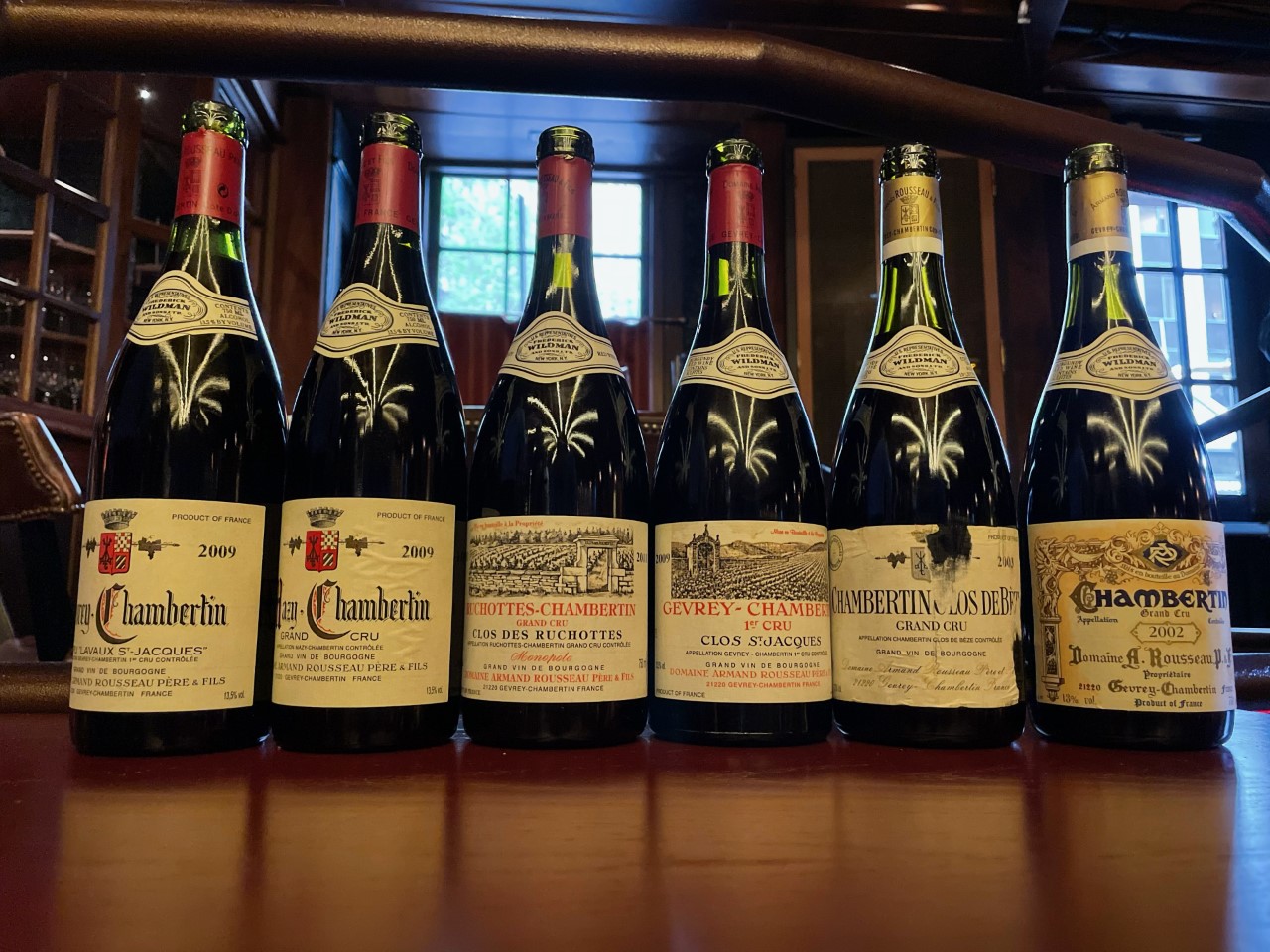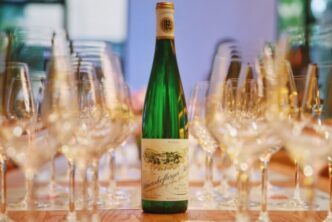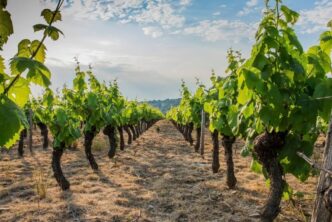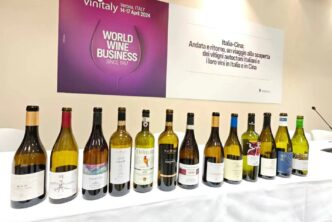2009 Gevrey Chambertin Lavaux St. Jacques 1er Cru 90
2009 Mazis Chambertin Grand Cru 92
2011 Clos du Ruchottes Ruchottes-Chambertin Grand Cru 93+
2009 Gevrey Chambertin Clos St. Jacques 1er Cru 95
2002 Chambertin Grand Cru 92?
2003 Close de Beze Grand Cru 96

“Rousseau’s wine are rich in color, pure in texture, always balanced, vigorous and very classy. They get round and velvety sooner than other ‘Gevreys’. They are all quite distinctive. This is superb wine making.” —Clive Coates, The Wine of Burgundy.
On Thursday evening May 19th, eight of us assembled at Harry’s of Hanover Square (more than a restaurant, a NYC institution) to taste six of the best Gevrey Chambertins from that famous village’s most iconic estate: Domaine Armand Rousseau. Since the 2005 vintage the top wines from Rousseau have become collectibles whose after-market prices surpass all other red Burgundies with the exception of Domaine Romanée Conti, Bize-Leroy and Ligier-Belair. One of the tragedies of the inflated prices of collector Burgundies is that, as a consequence, they are rarely drunk. Rather than potables, they have become status objects, ego possessions or trading vehicles. The removal of so many magnificent wines from their original function—to be tasted and appreciated among friends—would have been unimaginable to wine producers and consumers thirty years ago. Great wine was made to be enjoyed. The greater the wine, the more likely that the experiences they create will be remembered for a life time. Anyone who is serious about wine can recall in vivid detail every aspect connected with the tasting of great wines. These memories and the telling of the stories of these wines is part of the miracle of wine. That the Greeks and Romans had a god of wine makes perfectly good sense to all of us who have been privileged to experience outstanding wines in the company of like-minded tasters all united by the magic of great wine.
We had the tasting at a most appropriate location: Harry’s of Hanover Square. This venerable restaurant dates back to 1972 when proprietor Harry Poulakasis opened his instantly successful establishment near Wall Street. A wine lover for many years, Harry built a cellar second to none in New York. An astute buyer with deep pockets he amassed a collection of Bordeaux, Burgundies and California Cabernets unequalled in Manhattan. With the assistance of Sommelier Jacob Daugherty, we were able to select five outstanding Rousseau Gevreys which have been perfectly stored from the day they came to Harry’s cellar. I added the 2002 Chambertin to complete the set. I am happy to report that there were no corked bottles or any over the hill wines. All were fresh, true to type and in pristine condition: Just what one would expect at Harry’s.
The sequence we tasted the wines in at our dinner is also the sequence these wines are presented in when tasted at the domain itself. We did not include the Charmes Chambertin or the Close de la Roche, the one non-Gevrey made at the domain. It is my opinion, and not mine alone, that neither of these two Grand Crus shine with the brilliance and individuality of the other wines in Rousseau’s portfolio and included in the tasting. The opinions and descriptions offered in the present report are mine; however, there was some difference of opinion among the tasters as to the ranking of the wines. Suffice it to say that everyone agreed that the top 3 wines were the Clos de Bèze, the Chambertin and the Clos St. Jacques, while opinions diverged on the exact quality level of the others. But that is fine, as one would neither expect nor want everyone to be in agreement! That would have been unnatural to say the least.

We tasted the first two wines as a pair. The 2009 Gevrey Chambertin Lavaux St. Jacques 1er Cru is a fine, ‘sweet’, lovely to drink Gevrey lacking only the attack and intensity of the other wines. The 2009 Mazis Chambertin Grand Cru from the same vintage had more volume, width and length, but it is not perhaps the best wine made from this fine Grand Cru. Once we got to the 2011 Clos du Ruchottes Ruchottes-Chambertin Grand Cru the quality meter started to kick into a higher level. The Rousseau family is very proud of their Monopole (one owner) Grand Cru. This vineyard produces a dark, complex, inward looking wine which pulls the taster into the glass rather than reaching out with welcoming arms. I admit to being drawn to the wine every time I taste it. The 2011 was not a vintage of any particular distinction, but nor did it interfere with terroir expression. Although all the 2009s, a very ripe vintage, were richer and more overtly expressive than the 2011, the Clos Ruchottes impressed in its reserved manner which allowed for the observations of many details. Rather like a very intelligent person who does not speak often but when she or he does, everyone pays attention.
Now we were ready for the big guns: The top 3 Rousseau wines—according to the family and just about everyone who has tasted their wine. The 2009 Gevrey Chambertin Clos St. Jacques 1er Cru is a massive wine in this vintage. The Rousseau’s are fortunate to own a wonderful vertical tranche of this, the greatest of all the 1er Crus in Gevrey. The volume, power and rich earthiness are irresistible. This is a Grand Cru in all but name. The 2002 Chambertin Grand Cru proved somewhat controversial. The 2002 was a vintage which aroused great expectations when the wines were first released. However, my experience is that they never quite blossomed as expected. The best 2002s are elegant, detailed wines with much nuance but lacking in brightness and intensity. Coming after the exuberant 2009 Clos St. Jacques, the 2002 Chambertin was a model of propriety, sophistication and minerality. The fruit here is subordinate to the vineyard itself. For several tasters it was the wine of the night. But not for me.
One always tastes the Clos de Bèze last chez Rousseau. It is the biggest, most complete of all their wines. I will confess that I regard Clos de Beze as the finest Grand Cru north of Musigny. By almost universal agreement, the Rousseau Clos de Beze is the finest among the 20+ wines made from this magisterial site. The 2003 Close de Beze Grand Cru (we Burgundophiles often affectionately call it simply Bèze) is a grandiose Burgundy of almost operatic dimensions. No doubt the extreme heat of the vintage pushed the wine to a degree of weight and power beyond the normal. Yet there was little sense of stress or exaggeration in the flavors. The Rousseaus clearly handled the heat with skill. As they say, the better the site, the more the wine is about what lies under the ground than what happens above the ground. I remember tasting the 2015 Clos de Beze from barrel and thinking that wine cannot get better than this. Several tasters thought that the 2003 version to be a bit over the top. Not being a fan of the 2003s in general I was delighted by the success of the wine. The Clos de Bèze seems to sum up everything that the Rousseau’s strive for in working the vines, the land and making their wines. It has the exuberance of the Clos St. Jacques, the complex minerality of the Chambertin and a third dimension of individuality that puts it into the select group of the top half dozen wines made in Burgundy.

 English
English



